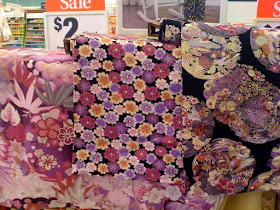The other half of the battle is getting fabrics that are appropriate for what you're trying to make. While it can be tough to find exactly what you're after, you can at least get in the ballpark with fabrics from local shops or on the Internet. You can also get actual kimono bolts (called tan or tanmono) at Ebay and other places online.
Kimono, depending on formality, are made of either 100% cotton, wool, high-grade polyester (not the cheap shiny stuff you see on bathrobes), or heavy and matte silk.
If you want to be traditional, make yours as following:
summer kimono (yukata) - cotton
small pattern for casual wear (komon) - wool, polyester, silk
visiting wear (tsukesage/houmongi)/most formal married women's (kurotomesode)/formal young women's with long sleeves (furisode) - silk
If you're not interested in getting the exact fabric traditionally needed and just want to make a kimono for a simple costume or cosplay, there are a lot of great cotton bolts out there that are Japanese-y enough to do the trick. Just make sure the pattern is actually Japanese and not Chinese (one of the biggest mistakes folks new to kimono make).
A good general rule is that "hard", geometric characters in circles, etc. are usually Chinese, as are lots of dragons, and anything made of shiny satin brocade.
Here are some samples of Japanese-themed cotton fabrics from Legacy Studio, found at my local JoAnn's a couple of weeks ago.


I am looking for a good sewing pattern for a furisode kimono,(I will need to be able to adjust the sleeve legnth for my height) with details on how to properly line it. I have some beautiful silk and I have been wanting to make a formal kimono for a long time. I have also been looking for a good naga-jubon pattern as well. Also, am I right in thinking that I will need an obi pillow as well as a mae-ita if I want to use a Darari knot for my obi? Thanks for any help you can give.
ReplyDeleteHello and thanks for your question!
ReplyDeleteLining a kimono is difficult work best left to professionals, to be honest. You're likely not going to find a ready-made pattern for something like that. For English speakers I recommend the Folkwear 113 pattern for an unlined kimono (changing the sleeve length is easy as the sleeves are just a long rectangular piece folded over in half at the top).
You can also use kimono patterns for naga-juban as they are structurally extremely similar, minus being slightly smaller wingspans and definitely shorter so they don't show at the bottom of the kimono.
Regarding the darari knot, are you making a costume? The reason I ask is that when made with a formal obi the traditional length, it is a very specific knot only worn by maiko, apprentice geisha, and never by normal women.
If you are making a costume that involves that knot, you will need a much longer obi that you will have to make yourself or find (for hundreds of dollars) vintage online as the knot requires much more length than a normal woman's fukuro obi will have.
If you scroll all the way down on this page, you can see some visual step by step on how to tie it. It does involve an obi makura (pillow).
http://www.immortalgeisha.com/ig_bb/viewtopic.php?t=5448
Let me know if you have any other questions!
Thank you for getting back to me. If you have a direction to point me in for lining that could help me a great deal. I'm an expert seamstress and have made my own patterns before, having one or one to jump off from is just so much easier. I am aware of the significance of the Darari obi knot, the legnth and that they are worn by maiku. I already have the materials and have planned for the extra legnth (I make a lot of clothing from Japanese patterns, so I can convert metric to standard measurements fairly accurately without an exact converter.) I plan on kind of making my kimono a "fusion" outfit. I'm 3/4 Native American so, I plan to embroider my tribe's clan symbol instead of the family crest on my kimono. I also plan to add intricate seed bead work alongside the embroidery. I have done a lot of research into the history, traditions and construction of the kimono and think it is a beautiful outfit. Since I have no Japanese family heritage to put into my own personal one that I'm making, I want to bring mine and try to still show respect.
ReplyDelete